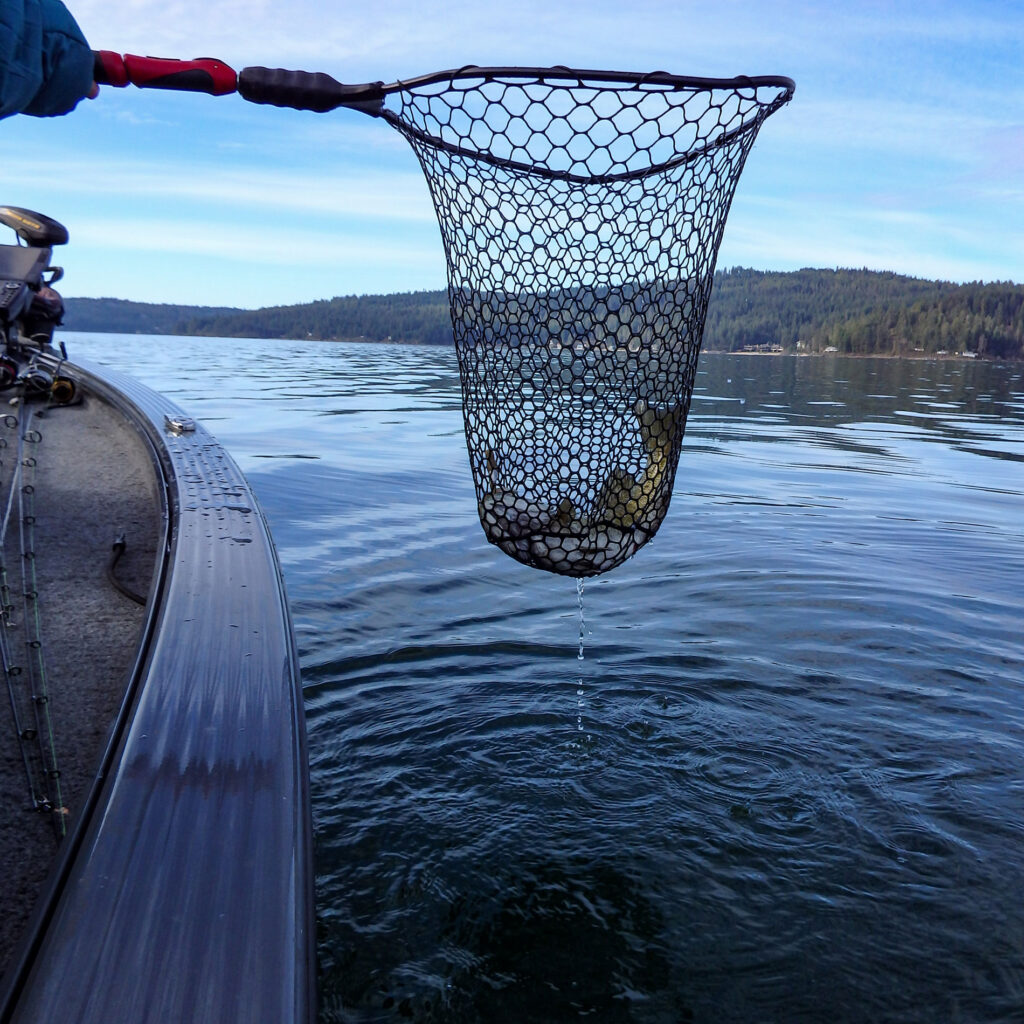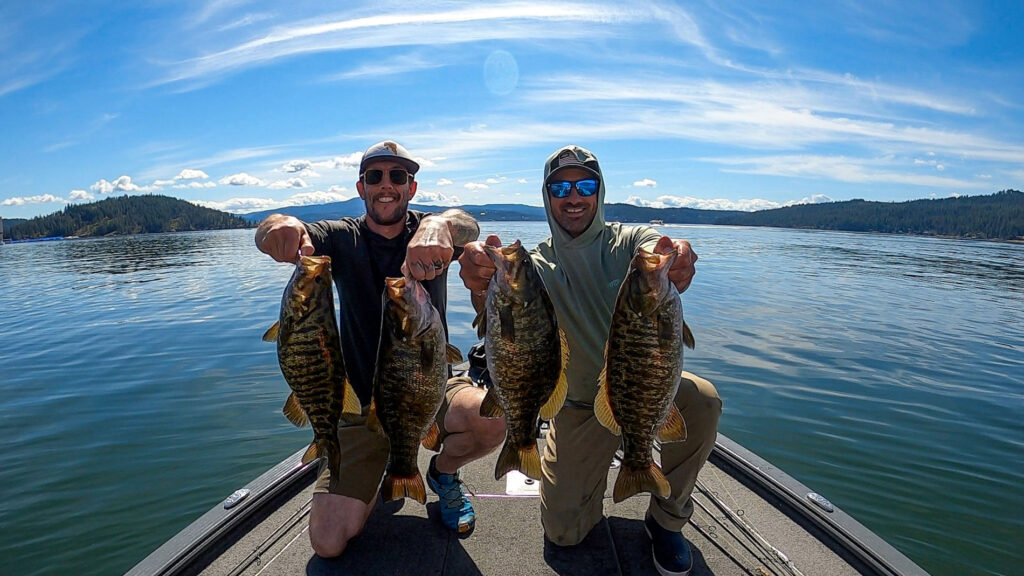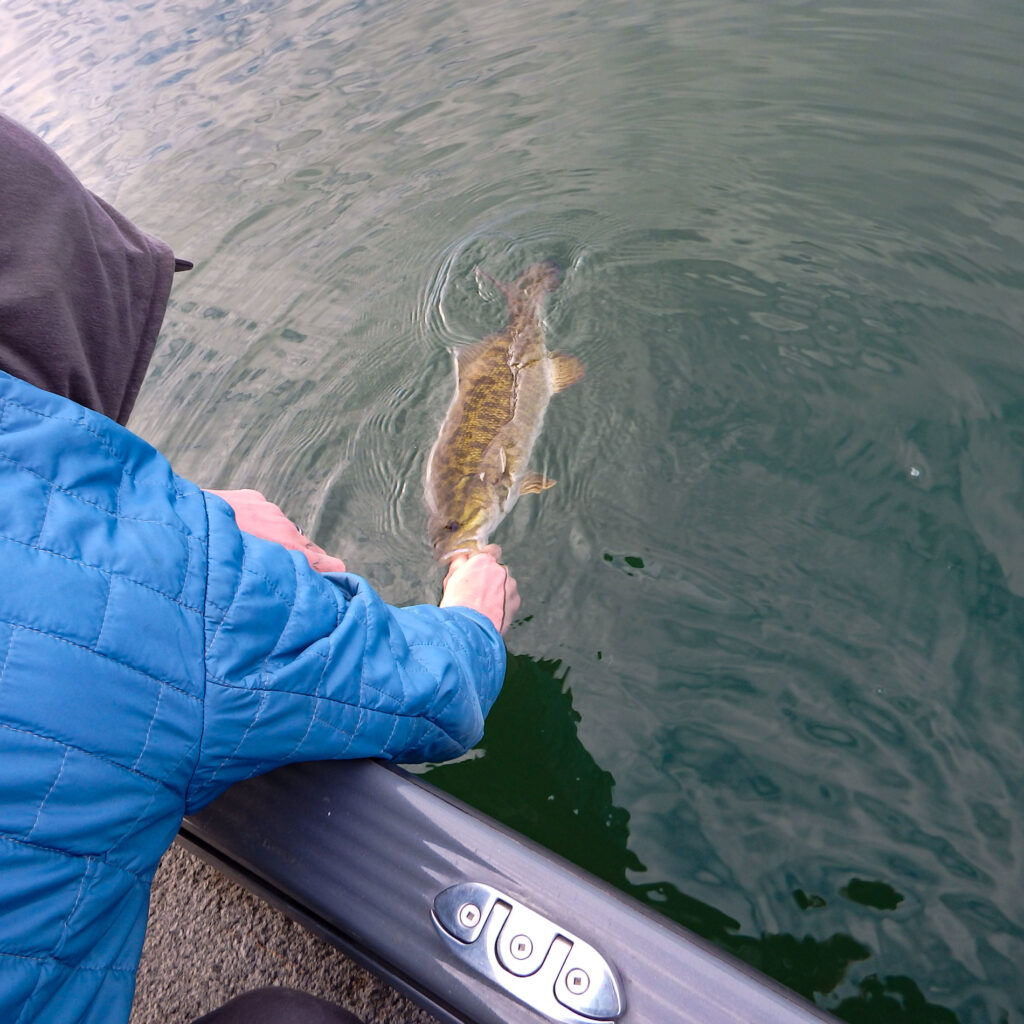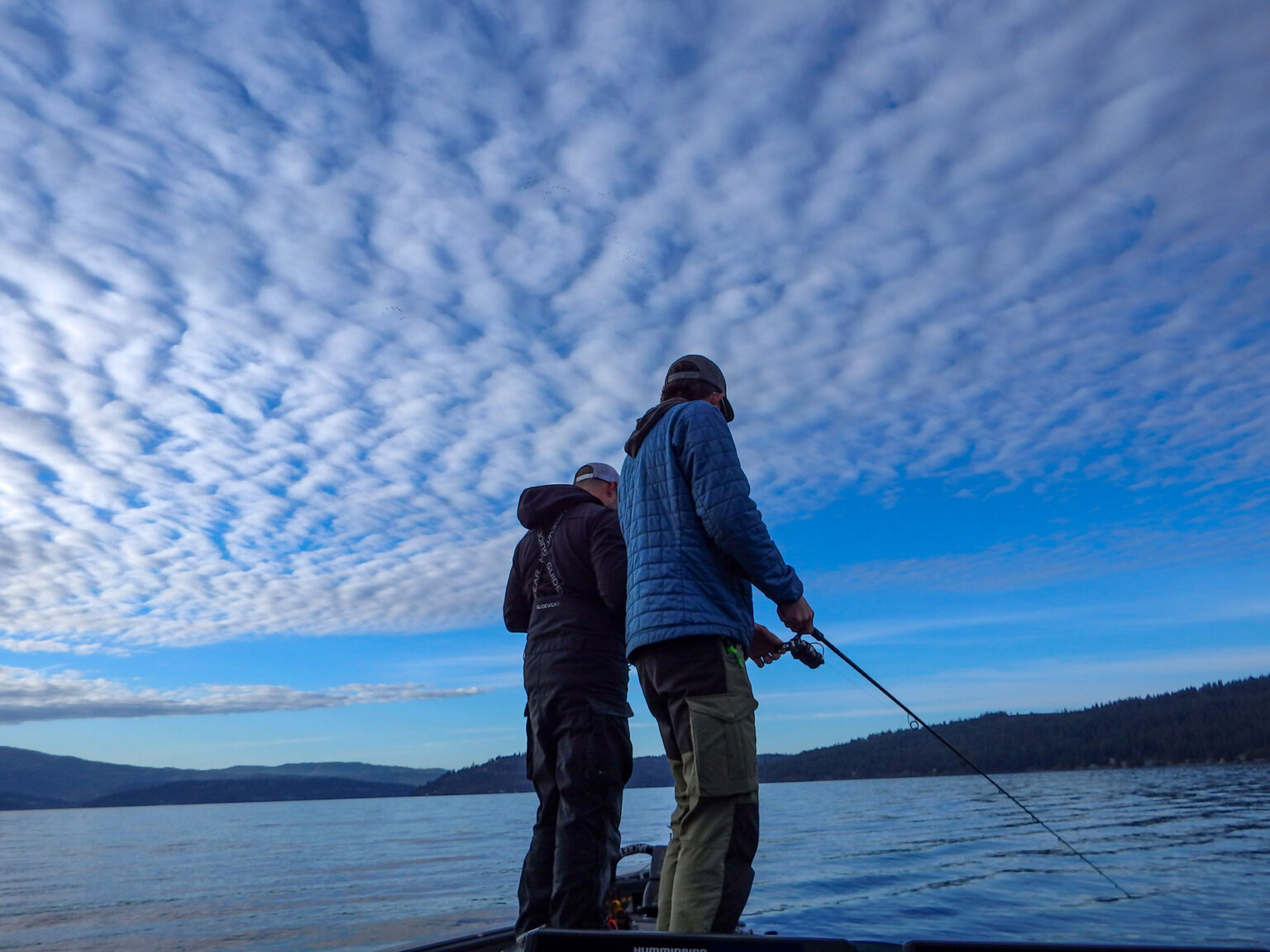With the first cast, I wondered whether my fishing plans would be successful. The lake was glassy calm, the sun was rising over the mountains above Beauty Bay on Lake Coeur d’Alene. This early spring day looked so promising I’d even brought shorts, which I had to dig out from the depths of my closet. Everything was primed for an awesome day of fishing, except for one minor fact: I am not a fisherman.
Jesse Kroetch and I had been talking for several months about this adventure. I wanted to write a story about fishing, and Jesse wanted to share his love of fishing for smallmouth bass on Lake Coeur d’Alene. We watched as spring progressed and the water began to warm. Finally, we settled on a date. I would be Jesse’s first client of the bass fishing season.
After meeting Jesse at the boat launch, we stowed gear and made our way across the lake to our destination, an area Jesse believed was just “comin on.” I pulled my hood tight and tucked into the wind that was just on the verge of being cold. As the boat came off-plane and slowed into the area where we would fish, I was thankful for the respite.

The great fishing continues as the morning warms. Several surprisingly large bass are caught and placed into the live well.
In my early 30s, I worked for several years as a water quality and fisheries technician, where I had the opportunity to be part of a Pacific White Sturgeon project on the Columbia River. I spent three summers working on every aspect of the project, from data collection, deploying egg mats, catching sturgeon on set lines and transporting viable sturgeon to a tribal hatchery for spawning. At the same time, I worked on several other projects where I electro-fished local creeks and lakes, conducting trout surveys and tracking invasive common carp. I could identify nearly every species of fish we have in the Inland Northwest, but I have almost never fished with a pole.
I know very little about fishing as most people understand it, so on that first cast on Lake Coeur d Alene, I was very much out of my element. However, I enjoy learning new things. I also enjoy watching someone who is in their element and passionate about what they do.
Jesse, who works with CastCadia Outfitters, is clearly passionate about fishing. He talked me through what he called “technical bass fishing,” techniques such as fishing with a lure that mimicked a crawfish crawling along the rocky bottom. Initially, I struggled to get the feel for the lure as I dragged it across the lake bottom, not sure of what I was feeling until the moment I felt exactly what Jesse had explained.

A smallmouth hit the lure hard. Surprised, I made an attempt at setting the hook and began reeling in. As it neared the boat, I was excited to see that the bass was fairly large, not what I expected for the morning and somewhat of a vindication that I CAN catch fish with a pole! Jesse was ready with the net and brought the fish into the boat. I posed for pictures, the bass went into the live well and I went back to fishing, determined to catch another.
With me this morning, as I tried in vain to look like I knew what I was doing, was my wife, Lindsey, who offered to help with photography on my promise of sunshine and a beautiful lake morning.
As the sun continued to rise, offering the first sensations of warmth in the cool morning, the three of us talked about everything bass-related, from their life cycle and common ages of smallmouth in Lake Coeur d’Alene, to the varying methods of catching them. Jesse shared with us his thoughts on integrity in guiding on Lake Coeur d’Alene. Lindsey was excited to learn we would be releasing all the bass we caught as Jesse firmly stood on the belief that releasing the fish, which grew slowly in our cold water and could range in ages up to 20 years old, was being a good steward of the lake he loved and grew up on.
Slowly, I began to get the feel for fishing with the crawfish lure, and then we moved onto another lure that mimicked a sculpin, which is a freshwater fish that bass feed upon. Somehow, I continued to bring in large fish, and I was getting better at distinguishing the feel of a rock to that of a bass taking the bait.
Then, Jesse had me switch to a jerk-bait. The method for using this lure was completely different and involved jerking the lure forward in short movements within the water column and mimicking a fish swimming above the bass. There’s a very specific jerking motion that makes this lure effective, which at first I was not achieving.
Jesse warned me that if conditions were right the bass would absolutely hammer the lure, and he wasn’t wrong. The first hit surprised me, and I didn’t set the hook correctly. The second time I was ready, or at least more ready, as I was still in disbelief. But I was able to set the hook and bring the fish into the boat. We were catching enough bass that the live well was filling up. Every time a large fish was landed, the smallest of the bass in the live well was released, so that only the largest of our day’s catch remained in the live well.
Other fishermen began to move into our direction as the morning progressed. While I was almost nearly preoccupied with trying to learn how to fish for bass, I was also able to watch and become aware that none of the other boats seemed to be catching anything. I asked Jesse why and he explained that many fishermen weren’t using the advanced techniques he had taught me.
I was learning bass fishing 201 while a lot of those fishing for bass were using 101 techniques. Also, a lot of experience and studying of bathymetry maps had resulted in Jesse having an acute knowledge of where the fish would be along the lake bottom. I was beginning to feel more and more like a legitimate bass fisherman.

Bass being released after a successful day of fishing on the lake.
Around mid-morning I took a break to change into my shorts and have a snack with Lindsey. We sat back and took in the surroundings, snapped some photos and watched as Jesse picked up a pole.
I will be turning 46 in a few months, 50 is just a few years away, so close I can see it just on the horizon. Aside from a five-year span when I worked in the environmental consulting world doing water quality and fisheries work, I’ve been a carpenter my entire life. I was taught how to be a carpenter by a generation of old school carpenters who had an immense measure of pride and integrity in their work. That’s something that has bled over into my life and a thing that I greatly respect.
As I watched Jesse cast his line, his passion for fishing was evident. He knew exactly where to cast, where the fish would be, and when the bass would come after his lure. I was witnessing a fish whisperer. I watched a few Bald Eagles fly overhead and considered how lucky I was to be in this moment.
With the morning winding down, I continued to fish with the jerk-bait. I felt like I was starting to get the feel for their necessary movement to draw a bass onto the lure, though I was still pretty horrible at accurately casting. On the side-scanning sonar, we could see a vague return of my lure in the water column and a blip on the screen rising to it. I felt the bass take the lure and set the hook, bringing in one final fish for the morning. We caught somewhere between 10 and 15 fish.

With the sun fully overhead and the morning complete, Jesse and I posed for photos with the four largest bass we had caught. We released them back in the same location where we had caught them and stowed our gear for the return trip across the lake.
As we began to motor back to the boat launch, other boats began slinking over towards our spot, in recognition of our evident success. Jesse laughed as he brought the boat up onto plane and told us that while we fished the north end of the lake there was a bass fishing tournament happening out of Harrison.
Jesse guessed that had we had been part of it, we would have likely brought home some winning money with our morning’s catch.
It was a fun and memorable fishing adventure. And while I may never consider myself a true fisherman, I did recently purchase a fly-fishing rod … just in case.
As Featured in the 2024 Summer/Fall Edition
By: Jason Wilmoth



